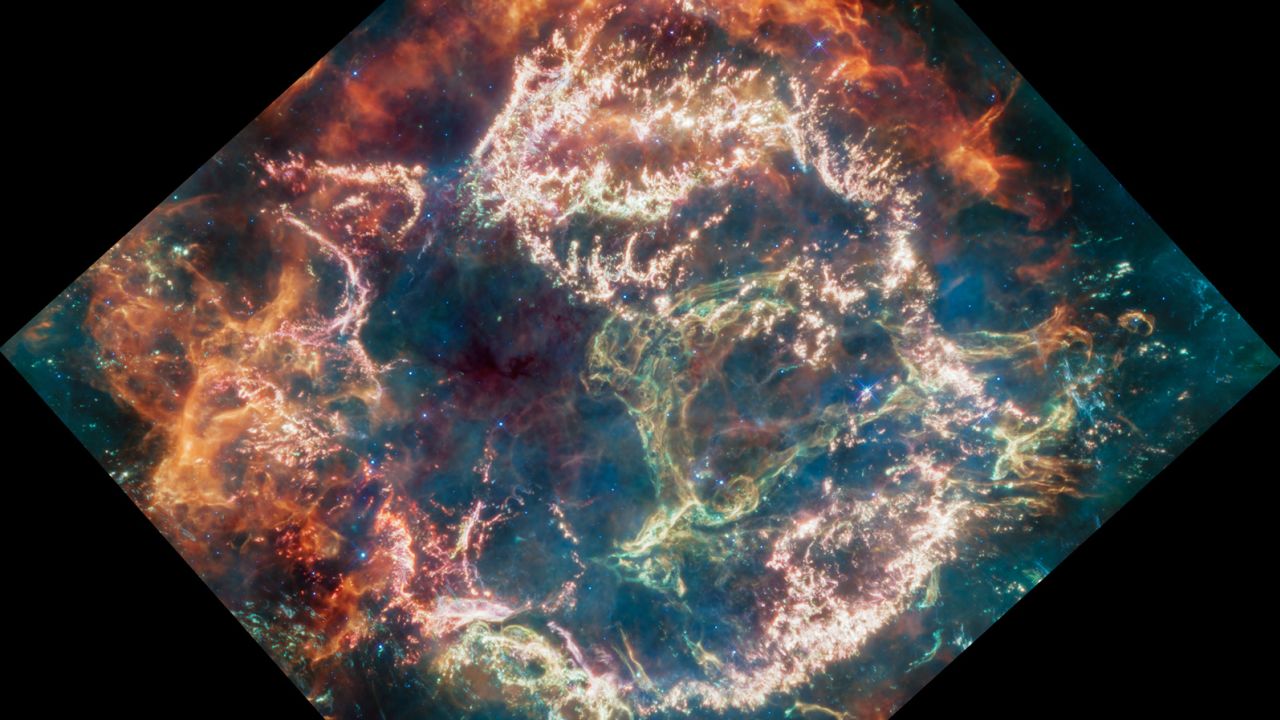(CNN) – The James Webb Space Telescope has captured unprecedented color detail in one of the best-observed remnants of an exploding star.
The glowing gas and dust of Cassiopeia A is all that remains of a star that exploded in a supernova and whose light reached Earth for the first time in 340 years. It is the youngest known supernova remnant in our galaxy, which is why the celestial body has been studied by many ground and space telescopes.
Cassiopeia A lies 11,000 light-years away, in the constellation Cassiopeia, with the rest spanning 10 light-years across.
Observing Cas A, as it is also known, allows scientists to better understand how stellar outbursts occur.
Astronomers pointed the Webb telescope and its instruments in the direction of Cas A to see if the observatory’s infrared capabilities could pick up something other telescopes might have missed. Infrared light is invisible to the human eye, allowing the Web to observe aspects of the universe that might otherwise be invisible.
“Cas A represents our best opportunity to look into the debris field of an exploding star and perform a kind of stellar autopsy to understand what kind of star was there before and how it exploded,” said Danny Milisavljevic, assistant professor at Purdue University. Webb’s principal investigator who captured the new observations, in a statement.
“Compared to previous infrared images, we see amazing detail that we couldn’t access before,” T. Timim, a research associate in astronomy at Princeton University, said in a statement.
The new infrared image of Cas A obtained by Webb has been translated into visible light so that the human eye can see the colors of the residue. The red-orange light on the outer surface of the remnant indicates hot dust, as material ejected from the star collides with the surrounding gas and dust before it explodes.
Within the bubble-like structure, a glowing pink light could be seen, along with clump-like features and nodes. This material comes from the exploding star and includes bright heavy elements such as argon, neon, and oxygen.
The colorful supernova remnant Cassiopeia A was captured in infrared light by the Webb telescope. Credit: NASA/ESA/CSA/DD Milisavljevic/T. Timim/I. from Looze
The bright green ring along the right side of the bubble also caught the researchers’ interest.
“We named it the Green Monster after Fenway Park in Boston. If you look closely, you can see that it’s dotted with what looks like little bubbles,” Milisavljevic explains. “Its form and complexity are unexpected and difficult to understand.”
The team is still trying to understand the sources of the different colors in the image.
Studying supernova remnants like Cas A can help scientists understand cosmic dust, which is a building block of stars and planets, and how exploding stars release elements essential to life.
“By understanding the process of exploding stars, we are reading the story of our genesis,” Milisavljevic says. “I’m going to spend the rest of my career trying to understand what’s in this dataset.”

“Proud web fanatic. Subtly charming twitter geek. Reader. Internet trailblazer. Music buff.”


:quality(85)/cloudfront-us-east-1.images.arcpublishing.com/infobae/7TXNTX4Z6ZADNGBBYTUT45QETM.jpg)
:quality(85)/cloudfront-us-east-1.images.arcpublishing.com/infobae/TR43PX4FQRCGJOYTK6DVVHHXGE.jpg)


More Stories
NASA finds rock on Mars that may contain ancient microscopic life
Astronauts stranded in space due to Boeing spacecraft malfunction won’t be able to return home for weeks
Download YoWhatsApp Plus 2024 Latest Updated APK for Android | WhatsApp Plus APK